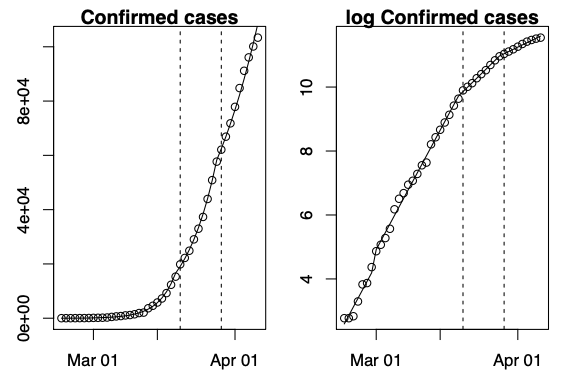Editor’s Note: The paper behind this column appears in the first issue of CEPR’s new initiative, Covid Economics: Vetted and Real-Time Papers.
On 5 April, the total number of confirmed cases of the coronavirus disease exceeded 100,000 in Germany. In light of the importance of COVID-19 for public health, economic consequences and well-being of individuals (e.g. Boeri et al. 2020), the German administration has, similar to several other countries across the globe, decided to take action. Since 13 March, schools and nurseries have been closed, and major sports events have been prohibited. On 22 March, the government and the federal states agreed to forbid gatherings of more than two people and closed restaurants and services such as hairdressers. Several states imposed more far-reaching lockdown measures.
Given a median incubation of 5.2 days (Lauer et al. 2020, Linton et al. 2020) and a certain delay between feeling symptoms, contacting a doctor, and the case being reported (perhaps 2-3 days), one would expect to see a first impact of the actions taken around 20 March, and a second impact around 29 March. If, as we expect, the policy measures impact the spread of COVID-19, the growth rate of the number of reported sick individuals should display a drop around 20 March, and a second drop around 29 March.
How to measure the impact of the German public shutdown
To investigate the impact of the German public shutdown, we study the development of the number of confirmed cases of COVID-19 for Germany (Hartl et al. 2020). Due to the high testing capacities of Germany compared to other industrialised countries – while acknowledging the natural uncertainty regarding unperceived cases – we consider German data on the number of confirmed cases with the novel coronavirus as a more reliable source of the actual number of people infected. We employ data from Johns Hopkins University (2020), which links data from the German Robert Koch Institute (RKI), the World Health Organization (WHO), and the European Centre for Disease Prevention and Control (ECDC).
Figure 1 Number of confirmed cases of COVID-19
Note: The left plot shows the data in levels, whereas the right plot takes logs. The data were obtained from the Johns Hopkins Coronavirus Resource Center.
Figure 1 plots the data for Germany in levels and logs from 23 February to 6 April. As it shows, in the first weeks the number of confirmed cases grows exponentially, such that taking logs yields a time series with a rather linear trend. Visual inspection suggests that the growth of log confirmed cases may have indeed slowed down at the end of the time series.
With these data at hand, we search for a structural break in the growth of log confirmed cases with COVID-19. A structural break implies a drop in the average growth rate of the virus disease from a certain day on, so that it takes longer for case numbers to double. In a first step we try to identify the point in time where a trend break has occurred. In the next step, we investigate whether the trend break is statistically significant, which implies that the break is likely to be systematic and not simply caused by random effects for a given statistical significance level.
Measuring the impact of the 13 March policies
In Hartl et al. (2020) we considered the impact of the policies implemented on 13 March, i.e. the closing of schools and universities, and the cancellation of mass events. We searched for a trend break by means of maximum likelihood (Bai 1997, Bai and Perron 1998) and found a statistically significant trend break on 20 March, seven days after the first intervention of the German administration. From 23 February to 19 March, we estimated a daily growth of 26.7%, implying that cases doubled every 2.93 days. From 20 March on, average daily growth reduced to 13.8%, which indicates a doubling each 5.35 days. We wrote our paper on 27 March, at which point we did not expect the 22 March policies to impact the number of confirmed cases due to the 7-8 day lag discussed above.
Measuring the impact of the 22 March policies
Since we now have data until April 8, we can search for a second structural break. If the 22 March policies influenced the spread of COVID-19, then one would expect a second drop of the growth rate 7-8 days later. Using the methods discussed in Hartl et al. (2020), we searched for a second trend break.
Figure 2 Sequential trend break search
Note: The graph plots the likelihood values corresponding to break at a certain day.
Figure 2 plots the likelihoods corresponding to a trend break at a certain day. The likelihood can be interpreted as a measure for the goodness-of-fit of a model, and the graph suggests that a trend break at 30 March explains the dynamics of the German COVID-19 data best, compared to possible trend breaks at other dates. Thus, a reduction of the growth rate of COVID-19 is found eight days after the implementation.
We include the second trend break into our model and obtain the following results. As revealed above, from 23 February to 19 March, the average growth rate of COVID-19 was 26.7%, implying that cases doubled every 2.93 days. From 20 March to 28 March the growth rate averaged 13.6%, such that cases doubled every 5.42 days. From 30 March on, we estimate an average growth rate of 5.8% and cases double every 12.20 days.
Figure 3 Fitted values for a log-linear trend model with trend break on 20 March and 30 March
Notes: The dots show the number of (log) confirmed cases, while the solid line sketches estimated confirmed cases. The dashed lines indicate trend breaks.
Figure 3 sketches the fitted values for a log-linear trend model with trend breaks on 20 March and 30 March. It shows that a specification with two trend breaks captures the dynamics of confirmed cases well. The two trend breaks indicate a slowed-down growth of confirmed cases for Germany.
Conclusion
This analysis extends our research in Hartl et al. (2020) on the growth of confirmed COVID-19 cases in Germany. We do so by including additional observations and drawing inference on the impact of the policies implemented on 22 March. We find that average growth of COVID-19 has almost halved from 20 March on. From 30 March on, we observe an average growth rate of 5.8%, implying that cases double each 12.20 days.
Concerning the bigger picture, one could conclude that Germany is approaching the area where cautious exit strategies are within reach. Donsimoni et al. (2020) forecast potential effects of exit strategies. They argue that if exit strategies differ across federal states, this would allow us to see which strategies are economically promising from both an economic and health standpoint. With regard to economic measures, the German authorities have decided on extensive support packages for companies and employees. Merkl and Weber (2020) argue that besides focusing on existing jobs, a rescue fund for new hires would be an important next step to prevent a collapse of the labour market.
References
Bai, J (1997), "Estimation Of A Change Point In Multiple Regression Models", The Review of Economics and Statistics 79(4): 551–563.
Bai, J and P Perron (1998), "Estimating and Testing Linear Models with Multiple Structural Changes", Econometrica 66(1): 47–78.
Boeri, T, A Caiumi and M Paccagnella (2020), "Mitigating the work-security trade-off while rebooting the economy", VoxEU.org, 9 April.
Donsimoni, J R, R Glawion, B Plachter, K Wälde and C Weiser (2020), "Should contact bans be lifted in Germany? A quantitative prediction of its effects."
Hartl, T, K Wälde and E Weber (2020), "Measuring the impact of the German public shutdown on the spread of Covid-19", Covid Economics: Vetted and Real-Time Papers 1.
Johns Hopkins University (2020), Coronavirus {COVID}-19 Global Cases by the Center for Systems Science and Engineering.
Lauer, S A, K H Grantz, Q Bi, F K Jones, Q Zheng, H R Meredith, A S Azman, N G Reich and J Lessler (2020), "The Incubation Period of {Coronavirus} Disease 2019 ({COVID}-19) From Publicly Reported Confirmed Cases: Estimation and Application", Annals of Internal Medicine.
Linton, N M, T Kobayashi, Y Yang, K Hayashi, A R Akhmetzhanov, S Jung, B Yuan, R Kinoshita and H Nishiura (2020), "Incubation Period and Other Epidemiological Characteristics of 2019 Novel {Coronavirus} Infections with Right Truncation: A Statistical Analysis of Publicly Available Case Data", Journal of Clinical Medicine 9(2).
Merkl, C and E Weber (2020), “Rescuing the labour market in times of COVID-19: Don’t forget new hires!”, VoxEU.org, 7 April.








